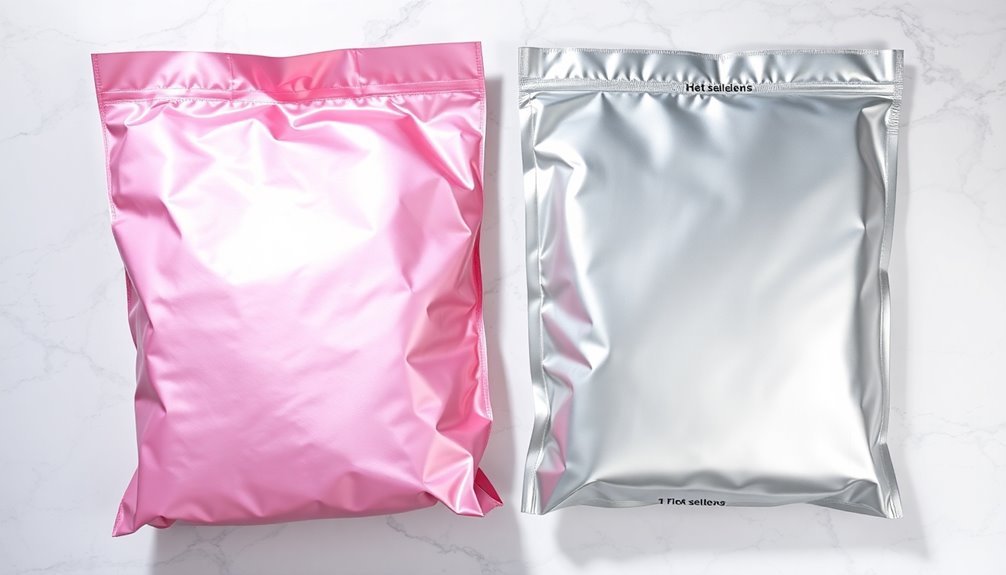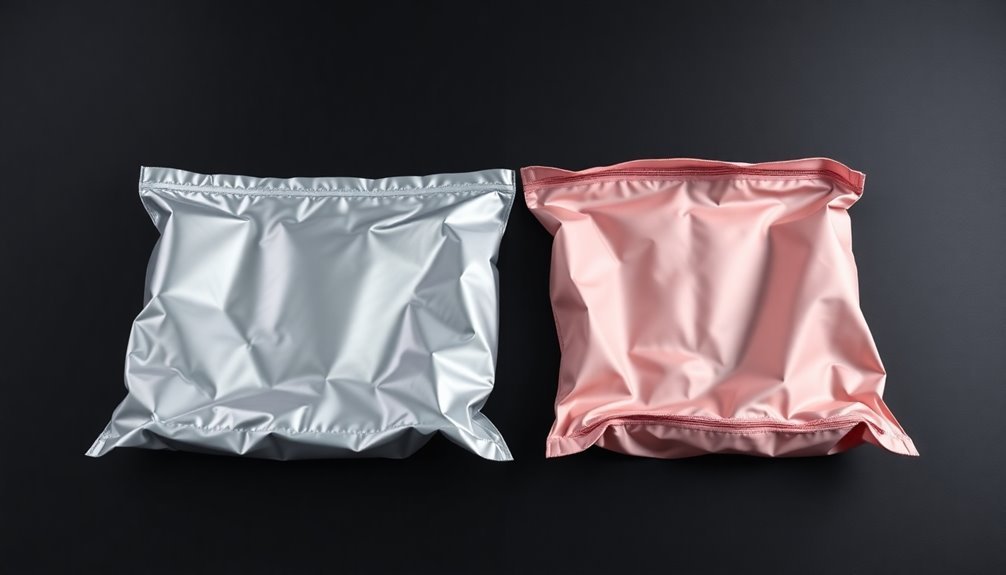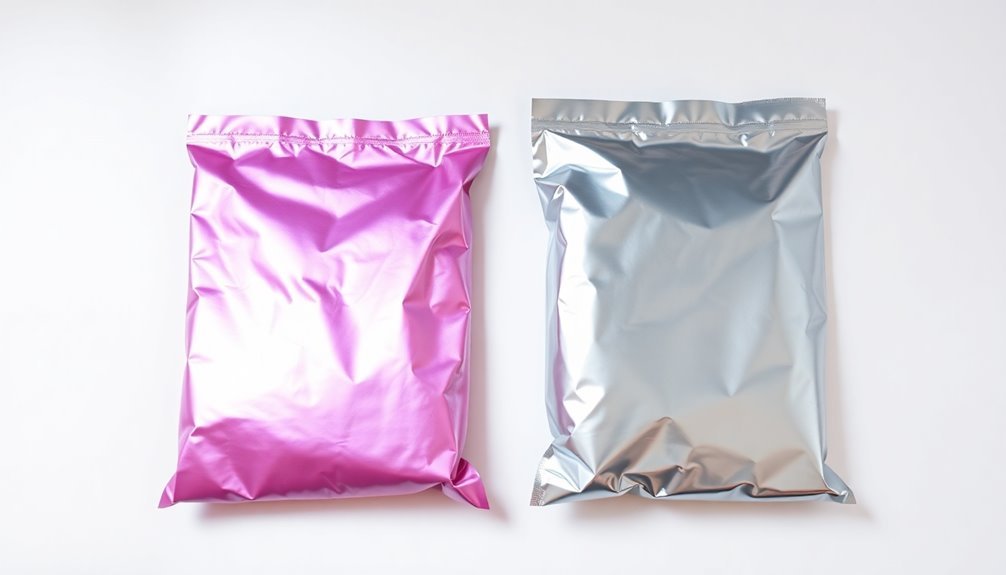Pink and silver protection bags differ in three key ways that'll help you choose the right one for your needs. Pink bags, made from LDPE with antistatic additives, provide basic static dissipation but won't shield against external charges, making them ideal for less sensitive components in EPA environments. Silver bags create a complete Faraday cage effect with their metallized layers, offering superior protection for highly sensitive electronics. While pink bags work well for short-term storage and transport, silver bags excel in long-term storage up to 2 years and meet strict military specifications. Understanding these distinctions can substantially impact your component protection strategy.
Material Construction and Properties

Diving into the material construction of protection bags reveals distinct differences between pink and silver variants.
Pink protection bags are manufactured using type II pink polythene film with an integrated antistatic additive, while silver bags feature a more complex multi-layered construction that includes conductive metallized polyester, aluminum, and protective coatings. These bags commonly use PET or LDPE as their base materials.
You'll find that pink bags rely on their surface properties to manage static, with a surface resistivity between 10^10 and 10^12 ohms/square. They're made through a blow-molding process using LDPE polyethylene and don't provide shielding capabilities. Instead, they focus on dissipating static charges to ground through their specialized coating.
In contrast, silver protection bags offer superior protection through their layered design. You're getting a Faraday cage effect thanks to the conductive metal layer, typically aluminum, which creates a barrier against external static discharge.
The bags also include an internal polythene layer and an external antistatic, abrasion-resistant lacquer. This construction doesn't just protect against static – it also serves as an effective moisture and air barrier, making silver bags ideal for sensitive electronic components.
Static Protection Capabilities
Three key aspects define the static protection capabilities of pink bags, though they come with notable limitations. While they effectively eliminate static buildup during packaging and shipping, resist triboelectric charges, and prevent damage to sensitive electronics, they won't protect your devices from external static discharges.
Unlike their silver counterparts, pink bags don't create a Faraday cage effect, which means they can't shield components from induced currents or EMP. They're designed to dissipate static charge rather than provide thorough protection, making them less suitable for highly ESD-sensitive items that need maximum safeguarding. The bags' surface resistivity levels measure less than 1×10^12 ohms/sq to enable effective static dissipation.
You'll find pink bags most useful when working with electronic components in static-controlled environments or handling less sensitive devices. They're ideal for storing circuit boards and integrated circuits that don't require high-level ESD protection.
While they're durable and tear-resistant, you shouldn't rely on them for protecting components from external static charges. If you're dealing with highly sensitive electronics or need complete ESD protection, you'll want to opt for silver bags instead, as they offer superior shielding capabilities through their metalized construction.
Usage Guidelines and Standards

Building on their distinct protective characteristics, both pink and silver bags come with specific usage guidelines and standards that determine their effectiveness.
Pink bags are made from LPDE with antistatic additives, designed for short-term protection when transporting non-ESD sensitive items into EPA environments. They're available in various formats, including grip seal and open top options, but don't offer shielding from external static charges. The bags must completely seal out air to provide optimal protection for the contents.
In contrast, silver protection bags meet military specifications (MIL-PRF-3420) and are certified for both commercial and military use. You can rely on them for long-term storage up to 2 years, as they're specifically engineered with VCI coating to protect silver and noble metals from tarnish and corrosion.
They'll safely absorb hydrogen sulfide and other corrosive elements without leaving harmful residues.
When choosing between the two, consider that pink bags focus on preventing static generation in EPA environments, while silver bags excel at metal protection. You can customize silver bags to your needs, and they're guaranteed safe for handling without compromising solder joints or surface conductivity.
For EPA environments, stick to pink bags; for metal protection and long-term storage, opt for silver bags.
Frequently Asked Questions
How Long Can Pink Antistatic Bags Be Stored Before Their Protective Properties Degrade?
You can store pink antistatic bags for up to 2 years if you keep them in temperatures below 100 degrees F. Be sure to protect them from heat, cold, sunlight, and moisture exposure.
Can Pink Bags Be Reused Multiple Times Without Losing Effectiveness?
You shouldn't reuse pink anti-static bags multiple times. They're designed for single use, and their protective properties degrade with each use. The material wears down, reducing its ability to dissipate static electricity effectively.
What Cleaning Methods Are Safe to Use on Pink Antistatic Bags?
You can safely clean your pink antistatic bags using a soft cloth with distilled water, non-abrasive antistatic wipes, or a vacuum with soft brush attachment. Avoid harsh chemicals that'll damage the protective properties.
Are Pink Bags More Cost-Effective Than Silver Bags for Large-Scale Operations?
Yes, you'll find pink bags more cost-effective for large-scale operations when handling non-ESD sensitive items. They're cheaper to manufacture and buy in bulk, offering significant savings compared to silver bags.
Do Temperature Extremes Affect the Protective Properties of Pink Antistatic Bags?
Yes, temperature extremes will affect your pink antistatic bags' protective properties. You'll notice reduced effectiveness in static dissipation, compromised material durability, and decreased tear resistance when exposing these bags to extreme temperatures.
In Summary
By understanding these key differences between pink and silver protection bags, you'll make better choices for your storage needs. While both offer ESD protection, pink bags focus on dissipative properties, and silver bags excel in shielding. Remember to follow proper usage guidelines, check your facility's standards, and consider your specific application when choosing between these two protective packaging options.





Leave a Reply